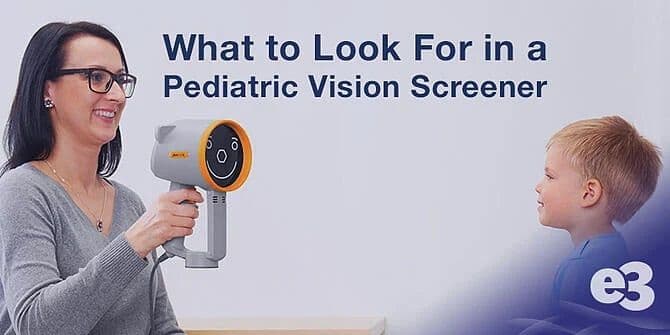What to Look For in a Pediatric Vision Screener

While vision screening is important in patients of all ages, it is especially critical for children. According to American Association for Pediatric Ophthalmology & Strabismus (AAPOS), 1 in 20 children are at risk of permanent vision loss due to disorders like amblyopia. The good news is, the same foundation states that 80% of these cases can be prevented or cured with early detection and treatment.
To ensure these vision disorders are detected and treated in a timely manner, it’s important to have a reliable vision screener that has the features needed to effectively test the eyes of children. If you’re a practitioner that frequently tests the vision of children, here is what you should look for in your next vision screener.
Transillumination Testing
In a transillumination test, a beam of light is projected into the eye and reflected by the retina. This helps illuminate the central part of the cornea, the lens, the vitreous humor, and the retina. By solely Illuminating these areas, the practitioner obtains a better image and can effectively spot dysfunction.
Some screeners, such as those manufactured by plusoptiX, leverage infrared technology to avoid glare and ensure the patient’s pupils remain large. As a result, the images are more suitable for checking whether abnormal retinal reflexes or media opacities are present.
Accuracy
As with any medical equipment,accuracy is of the utmost importance. When shopping for a new vision screener, make sure it’s been proven to be accurate in peer-reviewed clinical studies. Accuracy comes from a combination of different factors, such as the strength of the flashlight in the device, the measurement algorithm, and the resolution of the camera.
Because early intervention is of the utmost importance when screening children, you want to ensure your vision screener is as accurate as can be.
EMR Compatibility
In order to see and treat as many pediatric patients as possible, you can’t waste precious time manually entering test results into your EMR. You need a vision screener that can seamlessly integrate with your EMR so you can have patient data quickly and securely transferred automatically. This automated transferring of results saves precious time that can otherwise be spent treating more children and reducing their risk of permanent vision loss.
Reliability
When your job is to detect eye disorders in children, you can’t afford to have a vision screener that regularly breaks down or malfunctions. You also want to make sure it’s easy and inexpensive to download the latest software updates to your device. Additionally, you want an instrument that doesn’t need to be serviced or calibrated so you don’t have to worry about integrity of test results.
Vision screeners made by plusoptiX meet all relevant medical device standards and have passed independent testing. This guarantees the safety of your patients and reliability of results. Also, these screeners are built with no moving parts, meaning there is no risk for physical wear and tear. As a result, the devices never need to be serviced or calibrated. Not only does this save you money in service costs and reduced downtime, it gives you confidence that test results are always accurate so you can ensure your pediatric patients are receiving the treatment they need.
Having a vision screener with all the above will ensure that you can quickly and effectively treat pediatric patients and reduce their risk of permanent vision loss. Here at e3 Diagnostics, we carry a variety of vision screeners from plusoptiX that meet all the above criteria. To learn more, contact your local e3 office today!
